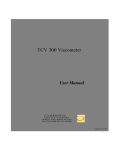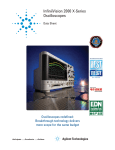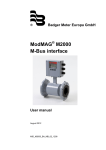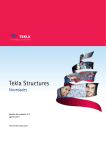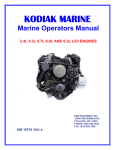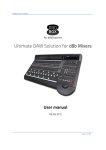Download Mackie DSR-1 User`s guide
Transcript
™ USER’S GUIDE DSR-1 DE-ESSER “ Plug-in for Mackie Digital Mixers ® ™ Iconography This icon identifies a description of how to perform an action with the mouse. This icon identifies a description of how to perform an action from the console. This icon will lead you to some further explanations of features and practical tips. This icon marks information that is very important, so please make sure you have a read. This icon does not appear in this guide. Note: Any future revisions of this guide will be available for viewing and downloading from our website: www.mackie.com. Further plug-in details and preset downloads can be obtained from www.acumalabs.com. “Mackie” and the “Running Man” figure are trademarks or registered trademarks of Mackie Designs Inc. All other brand names mentioned are trademarks or registered trademarks of their respective holders, and are hereby acknowledged. Part No. 0000651 Rev. A 12/2001 © 2001 Mackie Designs Inc. All Rights Reserved. 2 Acuma DSR-1 De-Esser Contents Iconography ----------------------------------------------------- 2 Introduction ---------------------------------------4 About Acuma Labs ----------------------------------------------4 About the D8B UFX Card -------------------------------------- 5 About the DSR-1 (De-esser) ----------------------------------- 5 Main Features ------------------------------------- 6 Let’s Get Started ---------------------------------- 6 Requirements ----------------------------------------------------6 Using the DSR-1 ------------------------------------7 Front Panel Overview ------------------------------------------ 7 The Status Block ----------------------------------------------- 8 Global Controls Block -----------------------------------------9 I/O Levels ------------------------------------------------------- 11 Controls Block -------------------------------------------------- 12 Meters (S-BAND and GAIN) ----------------------------------14 Specifications ------------------------------------- 15 DSR-1 Factory Presets --------------------------- 16 User’s Guide 3 Introduction Thank you for purchasing the DSR-1 (De-esser) from Acuma Labs. One of the exciting members of the new family of 24-bit plug-ins for the D8B, the DSR-1 has been specifically designed for the Mackie Universal Effects (UFX) card. The DSR-1 plug-in for the Mackie D8B is a highly accurate, frequency controlled, three-band dynamics processor. It enables you to quickly isolate and correct unwanted sibilance in vocal recordings of singers and speakers. The DSR-1 reduces annoying sibilant and popping sounds that are often found in recordings without losing the crisp top-end clarity. Don’t let the simple chicken-head controls and the funky retro-look fool you. The DSR-1 is a highly professional tool that is ideal for editing vocals, instrumentals, and other sources. The DSR-1 is an invaluable plug-in for your D8B that can save a great recording by removing troublesome frequencies. About Acuma Labs Acuma Labs develops real-time embedded systems for professional audio applications to create high-quality products for the music and pro-audio industries. Acuma specializes in digital audio effects using DSP, real-time operating systems, graphical user interfaces, and digital hardware design. 4 Acuma DSR-1 De-Esser About the D8B UFX Card The Mackie UFX card provides robust processing power for computation-heavy plug-ins. The UFX card is a 4-in/4-out architecture, which means that it supports four mono plug-ins or two mono and one stereo, or two stereo plug-ins simultaneously. Up to four UFX cards can be installed in the D8B, allowing up to sixteen simultaneous single-channel effects, eight stereo plugins, or combinations there of. Note: Earlier D8Bs were fitted with 16 MB of memory. It is recommended that you increase this to 32 MB (as fitted in newer D8Bs) if you install more than one UFX card. Memory upgrade instructions are supplied with each UFX card. About the DSR-1 (De-esser) The DSR-1 employs mid- or high-frequency compression. The frequency and bandwidth controls are used to isolate the problematic frequency range. No external keying device is required. The ess band Key Listen feature allows you to solo (or listen) to the isolated frequency range. The DSR-1 can also help to compress shrill, high-pitched sounds that may accompany acoustic instruments. The DSR-1 includes a high-pass filter that helps you to clean up other artifacts such as microphone pops. The DSR-1 includes a series of great male and female vocal, instrument, and spoken word presets that can make the toughest job easy to correct. As with all D8B plug-ins, all of DSR-1’s parameters are automatable, and can be saved as user presets. User’s Guide 5 Let’s Get Started Requirements • One or more Mackie UFX cards • Mackie Real Time OS 3.0 Software • Plug-in Software We will assume you have successfully installed a Mackie UFX card and Mackie Real Time OS 3.0 software upgrade. If you have encountered problems with the installation of hardware or software, please see their associated user guides or contact Mackie support (www.mackie.com). Please see the Licensing section of the Digital 8•Bus version 3.0 owner’s manual for information on both authorizing the plug-in, and the unlock procedure. Please see Appendix C of the Digital 8•Bus version 3.0 owner’s manual for information on configuring the plug-in. Main Features • • • • • • • • • • • • • • 6 Frequency dependant de-essing reduces problematic esses without loss of clarity High-pass FILTER helps to clean up unwanted artifacts such as microphone pops FREQ/WIDTH sets the frequency range for exact de-esser processing Built in DC filter eliminates DC offset from the input signal LISTEN enables you to hear the isolated ess frequency band Vintage look has a funky, easy-to-use interface WRITE button automates your edits into the D8B session Memory A/B are two convenient storage banks for A/B comparison ENABLE/Disable bypasses processing MENU has Load Preset, Save, Save As, Cut, Copy, Paste, etc. Factory/User Presets are Male, Female Vocal, Instrumental, etc. THRESHOLD adjusts the band energy level at which ess band compression starts occurring RATIO adjusts the amount of compression applied to the band Individual input, output, S-band, and gain reduction meters. Acuma DSR-1 De-Esser Using the DSR-1 Front Panel Overview You can think of the DSR-1 as being broken into five basic areas: the status block, global block, I/O block, controls, and meters. DSR-1 Block break down overview Status Block (See page 8) The status block includes the PRESET up/down toggle buttons, Preset Title window, and SOURCE (input select). Global Controls Block (See page 9) The global controls include: ess band (key) LISTEN, Mem A and B select buttons, MENU, WRITE, ENABLE, HELP, and minimize buttons. I/O Levels Block (See page 11) The I/O block is comprised of the input (IN) and output (OUT) meters and the INPUT level adjustment ranging from off to +12 dB. Controls Block (See page 12) The controls block is the heart of DSR-1. It includes the high-pass FILTER, as well as FREQuency and bandWIDTH control for selecting the ess band (ess range 1k to 20k). The controls block also includes the THRESHold control (–49 dB to 0 dB), and the RATIO control (1:1 to 100:1). User’s Guide 7 Meters (See page 14) There are separate meters to indicate the ess-band level and the ess-band gain reduction amount. The Status Block DSR-1 Status Block Preset Toggle Buttons The PRESET up/down arrows, located just to the left of the preset window, enable you to scroll up or down through either the factory or user presets. Tip: In most vocal recordings, there are usually a number of areas that could be improved with the DSR-1. However, there is not necessarily one overall optimum setting that will work throughout the track. Building user presets is a good way to have multiple De-esser settings that can be quickly accessed. You can then apply these settings to various regions of your track. There is no delay time in loading presets. You might try building performances by stacking user presets and toggling between them using the up/down arrows. These are located at the left side of the preset window. You could also insert a load preset event in the mix editor. For example, you can quickly switch from a Verse Ess to Chorus Ess preset and back. This would eliminate problematic spots in your recording. Additionally, pressing the WRITE button automates your changes as part of the D8B session. Note: See the section on the WRITE button for more information on how this works. The user preset list sorts alphabetically. If you want your user presets to come up in a certain order, use letters at the beginning of the preset names. (I.e. Aesss, Besss, Cesss, etc.). 8 Acuma DSR-1 De-Esser PRESET Title Window The PRESET Title window is located at the top of the control bar. It displays the currently selected preset corresponding to the existing DSR-1 settings. Click on the window to access the pull-down menu where you choose between factory or user presets. Note: It is possible to save presets to the User Preset folder, which is the default folder, or a folder of your own making. The user presets point to the last folder you’ve saved or recalled presets from. SOURCE The input select is located directly to the right of the PRESET Title window. Use your mouse to select from pre/post insert, auxiliary, or master insert inputs. In general, the DSR-1 is intended to be used as a channel insert. Global Controls Block DSR-1 Global Controls Block LISTEN The LISTEN button acts like a solo that lets you hear (solo) the frequency band set with the FREQ and WIDTH pots in the Controls block. Selecting LISTEN isolates (or solos) this range. This should help you zero in on annoying sibilance by using your ears to identify where the problem is occurring. Memory A/Memory B The Mem A and Mem B buttons temporarily store DSR-1 settings to allow comparative referencing. You can also copy and paste settings from one memory location to another. User’s Guide 9 MENU Pressing the MENU button opens a pull-down menu. This menu performs familiar functions such as load, save as, cut, copy, and paste. It also displays the plug-in’s build number and version. WRITE WRITE enables the D8B’s automation so all the changes you make in the DSR-1 plug-in are recorded as part of the D8B session. This works similarly to a channel’s write button. To record automation for a plug-in, ALL must be turned on in the automation section of the D8B. Automation must also be out of Bypass. Plug-in parameter edits are recorded when the D8B is recording, but only if the plug-in’s WRITE button is on, or if Auto Touch is turned on. Auto Touch is located in the automation section. When you press stop, the plug-in’s WRITE button turns off. ENABLE The ENABLE button either enables or bypasses the DSR-1. Help Screen (?) Pressing the help screen (?) button brings up a quick-start screen to quickly get you using the plug-in. It’s also useful for quick reference. The Help Screen Minimize Button (X) The minimize button (X) in the top-right corner hides the screen. However, the screen is still active until it is disabled in the D8B Plug-ins window. 10 Acuma DSR-1 De-Esser I/O Levels DSR-1 I/O Levels IN/OUT The input and output meters are located at the far-left side. These meters represent the incoming signal and the output (post effect) signal. OL OL (overload) is represented by the two small boxes above the in/out meters. The left-most overload indicator is for input level, and the other one is for output. They flash red if overload is occurring. INPUT The INPUT knob determines the gain or attenuation that is applied to the input signal. User’s Guide 11 Controls Block DSR-1 Controls Block Note: Only the signal in the band selected by the FREQ and WIDTH controls are affected by the DSR-1. Signal outside of this range, both above and below in frequency, is unaffected. FILTER The FILTER knob controls a high-pass filter ranging from 20Hz to 200Hz. It offers you a quick and convenient way to reduce low-frequency noise. The high-pass filter can be very useful in eliminating unwanted artifacts such as microphone pops. FREQ and WIDTH The FREQ and WIDTH pots are used to select the ess range. FREQ, ranging from 1kHz to 20kHz, is the center point of the range. WIDTH ranges from 1 to 100, with 1 being a very narrow band and 100 being very wide. Use your ears to locate a troublesome frequency range by enabling the LISTEN feature to hear a set ess range. Then use the FREQ and WIDTH pots to adjust the range. (See LISTEN in the Global Block description). A Closer Look: Start by routing a vocal track into the DSR-1. Typically use a pre- or post-insert, and set the DSR-1’s input to an acceptable level. Notice the relationship between your FREQ and WIDTH settings and the ess meter level. The ess meter level is located in the output meters block on the right side. Start by pressing the LISTEN button to facilitate isolation of the ess band. To start with, set the ratio to 1:1 so that no compression is applied to the band. Now adjust the 12 Acuma DSR-1 De-Esser FREQ and WIDTH pots so you hear as much of the problematic sibilance as possible. At the same time, minimize the amount coming through of the signal you wish to leave unaffected. Typically, you will find a center frequency in the range of 3k to 6k, with a width ranging from 20 to 40 is useful. Watch the key level change as you adjust to the frequencies of the ess range. Now adjust the DSR-1’s threshold level using the threshold pot. The threshold level is also portrayed as the small horizontal bar between the S-BAND and GAIN meters. Watching this is a good way to meter where your threshold level should be after you have dialed in an ess range. The DSR-1 only affects a signal that is above the set threshold. Finally, adjust your RATIO pot to apply a desired amount of compression to your specified ess range. For example, 3:1 means that if a signal is 3 dB over the threshold, it will be reduced in amplitude to 1 dB over the set threshold. Now you’ve got a good starting point. Take it out of LISTEN mode and continue to tweak the parameters until you’ve got the sound you want! DSR-1 threshold indicator and S-BAND/GAIN meters Note: You may need to change threshold levels to compensate for adjustments made with the FREQ and WIDTH pots. THRESH THRESH (threshold range) ranges from –40 to 0 dB, and is adjusted using the THRESH knob. S-band signal above this threshold will get reduced in amplitude by an amount determined by the ratio. See “A Closer Look,” above for further information. User’s Guide 13 RATIO The RATIO select is set to usual compressor increments that range from 1:1 to 100:1. Simply turn the pot to set a desired ratio. For example, 3:1 means that if a signal is 3 dB over the threshold, it will be reduced in amplitude to 1 dB over the set threshold. See “A Closer Look” on page 12 for further information. Note: The GAIN meter displays gain reduction. The LED moves downward from the top of the meter starting at 0 dB and indicates negative dB, or gain reduction. Meters (S-BAND and GAIN) The two meters in the lower right corner of the screen represent the S-BAND meter and the GAIN (reduction) meter. GAIN (Gain Reduction) The gain reduction meter ranges from 0 dB to –40 dB and the LED’s come down from the top of the meter, (0 dB), in an opposite fashion as compared to regular level meters. S-BAND The S-BAND meter represents the dB level of the ess band. The small white bar located between the S-BAND and GAIN meters is a visual representation of the threshold that can be adjusted using the threshold pot. Please see Appendix C of the Digital 8•Bus version 3.0 owner’s manual for information on: • Saving, loading and resetting a preset • Automation and snapshot control • Dynamic real time and dynamic off-line • FX routing 14 Acuma DSR-1 De-Esser Specifications In/Out Level meters -40 to 0 dB Input Control Off to +12.0 dB High-Pass Filter Off to 20Hz-200Hz (4th Order) Frequency 1kHz to 20kHz DSR-1 Plugin Configuration specifies the middle point of the ess band Width Narrow to Wide specifies the width of the ess band Threshold –40 dB to 0 dB Ratio 1:1 to 100:1 DSR-1 Plugin Load S-band (Key) Meter –40 dB to 0 dB Gain Reduction Meter –40 dB to 0 dB User’s Guide 15 DSR-1 Factory Presets The following table is a simple guideline to help you understand the factory presets, and what settings were applied to the individual presets. Don't be afraid to run anything through the plug-in preset, though. Then customize the parameters to your specific needs, and save it as a user preset. So get creative and have fun! Please visit www.acumalabs.com periodically to download more audio examples and free presets. Preset Name Frequency Width Ratio Description 2K Medium 2K 30 5.8:1 Frequency is set at 2K with a medium width 2K Narrow 2K 16 5.8:1 Frequency is set at 2K with a narrow width 2K Wide 2K 50 5.8:1 Frequency is set at 2K with a wide width 3K Medium 3K 30 5.8:1 Frequency is set at 3K with a medium width 3K Narrow 3K 16 5.8:1 Frequency is set at 3K with a narrow width 3K Wide 3K 50 5.8:1 Frequency is set at 3K with a wide width 4K Medium 4K 30 5.8:1 Frequency is set at 4K with a medium width 4K Narrow 4K 16 5.8:1 Frequency is set at 4K with a narrow width 4K Wide 4K 50 5.8:1 Frequency is set at 4K with a wide width 5K Medium 5K 30 5.8:1 Frequency is set at 5K with a medium width 5K Narrow 5K 16 5.8:1 Frequency is set at 5K with a narrow width 5K Wide 5K 50 5.8:1 Frequency is set at 5K with a wide width 6K Medium 6K 30 5.8:1 Frequency is set at 6K with a medium width 6K Narrow 6K 16 5.8:1 Frequency is set at 6K with a narrow width 6K Wide 6K 50 5.8:1 Frequency is set at 6K with a wide width Female 6K 22 5.8:1 Optimized for female singing or speaking frequencies Male 3.35K 34 3.8:1 Optimized for male singing or speaking frequencies 16 Acuma DSR-1 De-Esser Preset Name Frequency Width Ratio Squeeky Acoustic 3.8K 74 Fret Noise 3K 42 Sting Buzz 1 Sting Buzz 2 3K 4.8K 87 56 Description 13:1 Helps to reduce annoying string squeaks from acoustic guitars NA Used to diminish miscellaneous fret noise when close miking strings 27:1 ***Helps to hide buzzing fret and string noise 100:1 ***Helps to hide buzzing fret and string noise Try quickly punching DSR-1 in and out to eliminate noise without losing top end. User’s Guide 17 18 Acuma DSR-1 De-Esser User’s Guide 19 ® ™ ©2001 Mackie Designs Inc. and Acuma Labs. All Rights Reserved. Part No. 0000651 Rev. A 12/2001






















